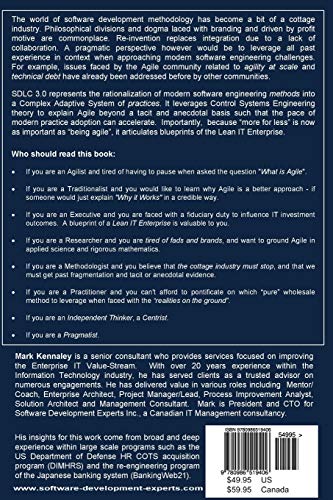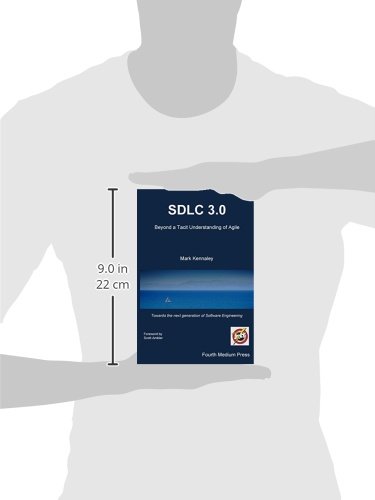Customer Services
Copyright © 2025 Desertcart Holdings Limited
Desert Online General Trading LLC
Dubai, United Arab Emirates





SDLC 3.0: Beyond a Tacit Understanding of Agile
M**
I Was Prepared To Dislike This Synthesis But...
Kennaley is obviously a brilliant man and he's delivered a wide-ranging, sometimes technical, mostly brilliant work. I have to admit I was prepared to dislike any attempt at a Lean / Agile synthesis with the Unified Process (UP) but, like the author, I'm a pragmatist at heart so he won me over about halfway through.The bottom line is that software development practitioners are far better served by a hybrid of best practices than the sectarian dogma of purists driven by profit. There were lots of hmm and ah hah moments for me, such as:- Debates over what is "Agile" and what is "Scrum-but" are silly and unhelpful; every methodology has to be adapted to context and situation.- The Agile community is plagued by "a lack of diversity:" "What is needed is not homogeneity of thought, but rather...people having differing knowledge backgrounds" who are willing to challenge "the established dogma."- The Agile community has been less than forthcoming about the challenges of political and economic realities on the ground, distributed teams, and scale. Solutions may be derived by "leveraging the entire field of modern software engineering practices." I was hoping the author would also address the challenge of estimating large, fixed scope programs but didn't find it.There is also a helpful discussion on optimizing the length of iterations by project phase, risk, and complexity.In the end, Kennaley seems to favor Lean with an appreciation of UP's emphasis on architecture and risk mitigation and Agile's focus on human factors.Towards a "SDLC 3.0" is an ambitious undertaking; I recommend this book as an important step in the right direction.
J**A
An excellent summary of SDLC and directions for the future
When I first picked up SDLC 3.0, I was very interested in Mr. Kennaley's explanation of the various software development life cycles being used and how they could work together. With a perspective of "use what works" rather than the Scrum/XP/RUP/Lean/etc (pick your favorite) is the only way, Mr. Kennaley does an excellent job of explaining the various Agile methodologies, how to combine them, why waterfall doesn't work (if you are into mathematics, you will enjoy chapter 3, where he uses systems control theory to explain why Agile works and why waterfall does not) and then he looks forward to the next generation of SDLCs (hence the 3.0 title).If you are looking for a book the explains the various Agile approaches without taking sides, as well as where things are going, this book is a great one for it.At times, though, I felt that Mr. Kennaley could have delved deeper into some of the sections he painted with a broad brush. For example, while the diagrams are good (would have been nice for some of them to be bigger though) the explanations, at times, seem lacking. The last chapter, chapter 9, the one that paints the road ahead, seemed not to wrap the story enough. Hence four and not five stars.These are minor issues in comparison to the work Mr. Kennaley has done in pulling all these methodologies together and pointing the way forward.
K**S
Great Broad and Deep Overview
I am a network planner, hardware deployments generally. I was asked what I knew about software project management and answered truthfully, not much. I stated that it was another world with another set of acronyms but I would figure it out. I purchased this book due to it ratings and other reviews. I got a little lost on some of the math but that isn't the point of the book. I now feel as though I know more about software project management than anyone who has never done it for a living. Needless to say I learned a lot, there are a number of methodologies but following the best practices of a few of these and employing a pragmatic attitude will go a long way. SDLC is high science and this is well worth the read. Well written,please publish in Kindle so we can highlight important points; there are a lot of them.
P**O
history of methodologies
good preparation and collection of ideas about development methodologies
C**N
Five Stars
very good...
S**R
Must read for software professionals
I treat my books harshly, highlighting important ideas and writing my observations and thoughts in the margins as I read, and my copy of SDLC 3.0 is marked up severely. This book presents a realistic and reasoned view of agile software delivery. Note how I use the term delivery and not just development - this book goes far beyond the software development life cycle to consider the full delivery life cycle. It in fact, it goes further to consider how to apply agile and lean concepts at the enterprise level.If you're a software professional and truly serious about understanding your craft, then this book is a must read.
C**S
Provides views that are fascinating
SDLC 3.0 provides very unqiue perspective not just on the the state of SWD approaches and its history but also a vision (perhaps a mandate) and rationale on how the industry should move forward. Found the chapter on systems theory as it related to project management uniquely fascinating. Though the math is pretty complex, I still got the essence of the approach and interpretations.Mark writes in a unique voice as compared to other books in this category. This just enhances the content and ideas... Enjoyed the change of pace and view.It has been a good read - went slowly to fully absorb - and a good chum the last few weeks. Highly recommended.
W**E
A refreshing view
This text provides excellent educational value--whether you are a student or a seasoned practitioner. The mathematical perspectives are insightful and help to illuminate some of the "why" underneath our current understanding of modern software practices and methods. Mark provides a balanced perspective across many methods and processes without coming across as a zealot in any specific approach. That objectivity and the diverse insights were well worth the time.
Trustpilot
1 month ago
1 week ago